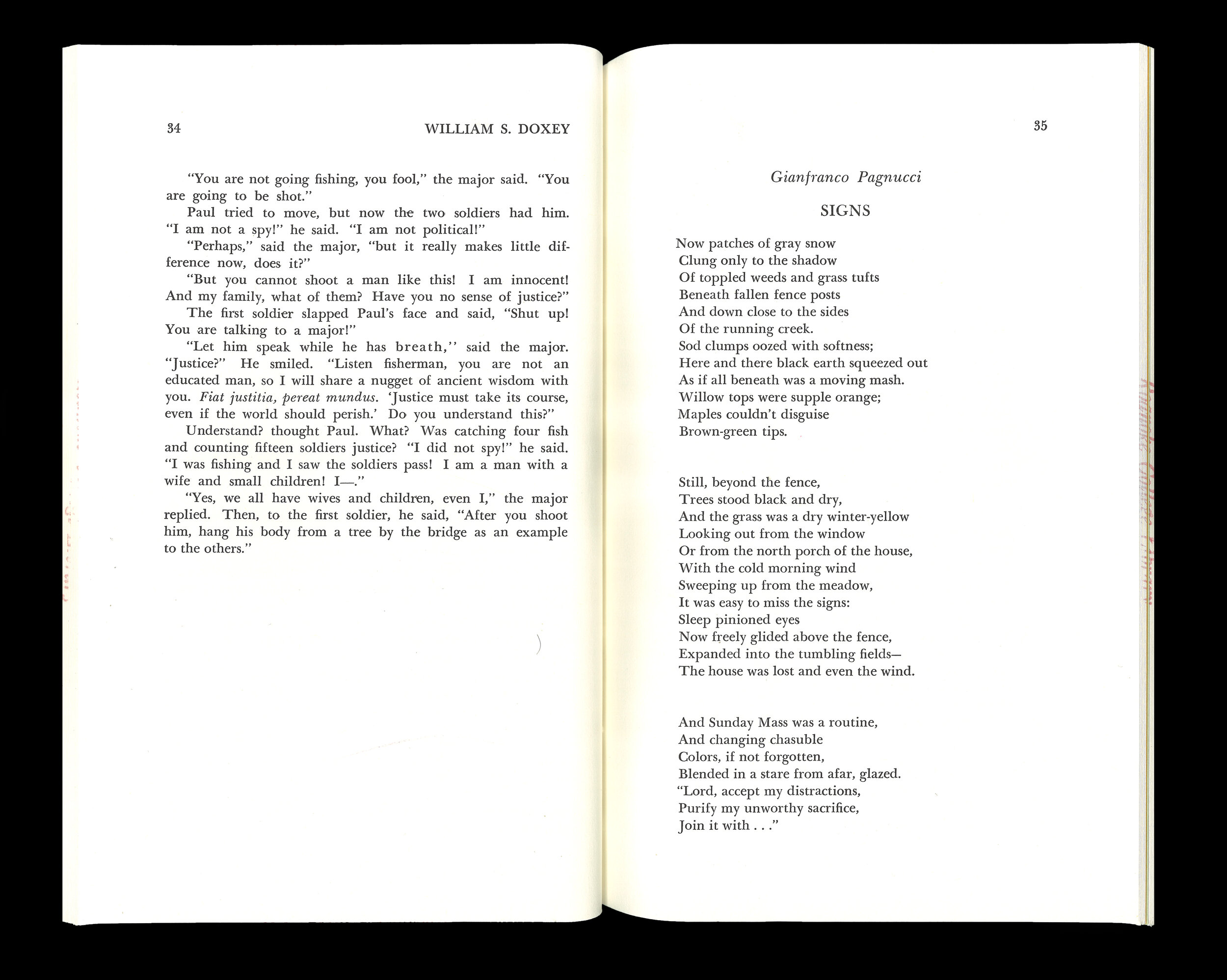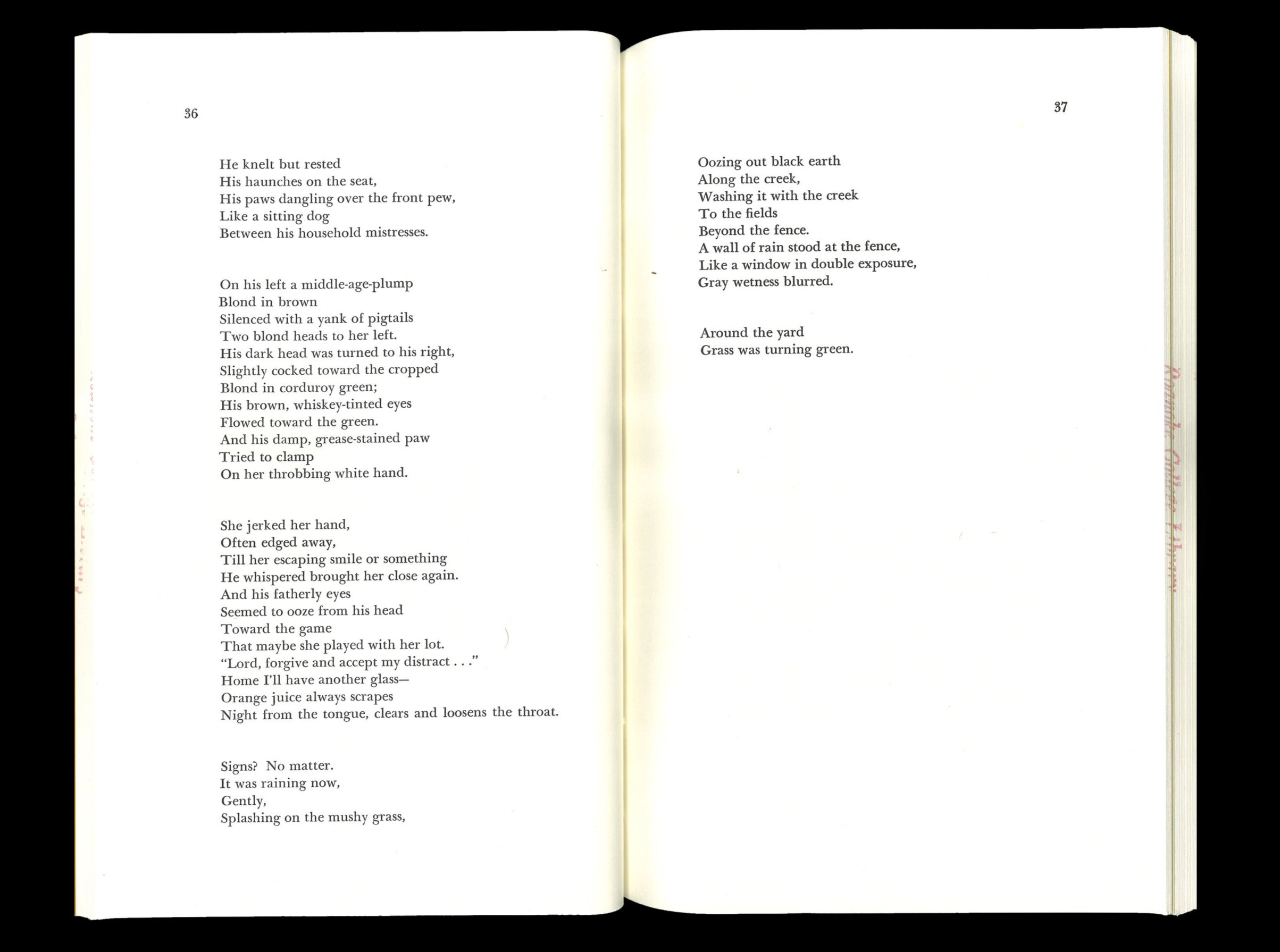Gianfranco Pagnucci
/fall 1971
SIGNS
“Orange juice always scrapes / Night from the tongue, clears and loosens the throat. ”


BY GIANFRANCO PAGNUCCI - FROM ROANOKE REVIEW, 1971
current work
DAUGHTERS
for William & his daughter, Lee Ann
That year’s offspring hung around,
sitting on her favorite branch
four feet above the nest,
calling out—
So sad a cry,
Kathy our young neighbor said.
Makes you feel sad. And every day
that sad cry!
It was just October
in the north lake country.
Sunny. Cool that day.
The rains for a while were gone.
Full fall colors falling fast.
Then, in early October
the immature hadn’t come back.
All night. In the morning one of the adults
sat silent above the nest. No calls out.
Even as I came up from the house
and started piling brush to haul away.
This was a fall ending. We had waited,
since early July,
but everything that year was late.
When Obama dropped off his daughter, Malia,
for college, he said how later, only later,
in the car on the way home did he sniffle.
Time goes so fast, he said.
The little things are what we remember.
Quiet talks after school, pushes on the tire swing …
My longtime friend Bill, a professional psychologist,
when he told me about his daughter’s
approaching marriage, choked.
Couldn’t say where she was moving,
touched me on the shoulder so I’d understand.
Leaving home is a fall ending.
That early October day, the bald eagle
sitting, all morning sitting so silent,
made me miss my daughter
building their place fifteen-hundred miles away
along the salt marshes of North Carolina.
a note from the author
I wrote the poem, “Signs,” many years ago, and when I recently read it so I could say something about it, I found that it felt unfamiliar to me as it might to a new reader. However, I recognized the style—the natural world woven around a human experience.
That’s my style of poem, I thought, a familiar process where the human experience is given in a short, tense anecdote, the natural world around it (here spring) doing its thing. “Signs” also uses vivid images, and the emotional tension is typically shown rather than told. Still, I found “Signs,” on the whole, a little obscure.
“Daughters,” a recent poem, I picked as the companion piece for its similar style and presentation to “Signs.” However, even on a first reading one feels much more comfortable with the poem, “Daughters.” The pace is quicker, smoother. The language is tighter, the images and short anecdotes are clearer and more packed with recognizable nuances. As a whole, “Daughters” is easier to understand. Not surprising, looking at both poems, I find that my concerns remain focused on trying to grasp how we fit in a real place and how our place fits into the larger natural world around us. Also, I’m glad to notice that I still use strong images to give an emotional awareness rather than an intellectual one. My dentist’s comment after reading “Daughters” is a typical response: It’s a beautiful poem. It made me tear-up, he e-mailed. Thanks for sharing.
photograph of gianfranco pagnucci by susan m. pagnucci
Gianfranco Pagnucci, Emeritus Professor of English at the University of Wisconsin – Platteville, has published storytelling books for teachers and students as well as seven volumes of poetry: Firstborn (2016), Breath of the Onion: Italian-American Anecdotes (2015), Tracks on Damp Sand (2014), a chapbook Imprints of Your Tires on Damp Sand (2012), Ancient Moves (1998), I Never Had a Pet (1992), and Out Harmsen’s Way (1991). He has also been the editor for two anthologies: New Roads Old Towns (1988) and Face the Poem (1979). His essays have appeared in such publications as The Christian Science Monitor and Commonweal. His poems have been published in many periodicals and anthologies, including News of the Universe, American Voices, and Best American Poetry 1999. He and Susan Pagnucci, a paper artist, live in the lake country of northern Wisconsin, where they work on handmade poetry books. Firstborn was selected “Outstanding Work of Poetry, 2017” by the Wisconsin Library Association.

